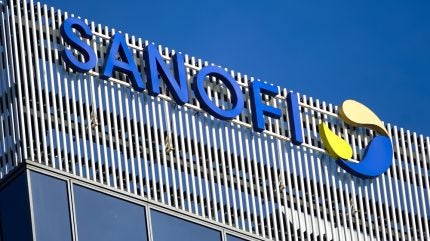
Sanofi has won US Food and Drug Administration (FDA) approval for haemophilia treatment Qfitlia (fitusiran), as the company aims to use the drug’s versatility to set it apart from rivals in a crowded market.
Qfitlia is approved for adults and adolescents with haemophilia A or B with or without factor VIII or IX inhibitors. The ability for Qfitlia to be used regardless of inhibitor status gives an advantage over other approved therapies. Inhibitors are antibodies that some haemophilia patients develop that prevent factor replacement therapies from working properly.
Sanofi’s drug is also the first antithrombin-lowering therapy for routine prophylaxis to prevent or reduce the frequency of bleeding episodes in patients with the disease.
Haemophilia A and haemophilia B are genetic bleeding disorders caused by a dysfunction or deficiency of coagulation factor VIII or IX. Qfitlia does not replace the missing clotting factor, instead, it acts by reducing the amount of a protein called antithrombin, leading to an increase in thrombin, an enzyme critical for blood clotting. Qfitlia uses small-interfering RNA technology, which enables low treatment frequency, subcutaneous dosing, and low-volume injections.
Qfitlia has demonstrated efficacy across the different types of haemophilia in three completed Phase III trials: ATLAS-INH (NCT03417102), ATLAS-A/B (NCT03417245), and ATLAS-PPX (NCT03549871). Compared to patients taking on-demand clotting factor concentrates and bypassing agents, Sanofi’s monthly subcutaneous treatment reduced annualised bleeding rates by 90%.
The most common adverse events (AEs) with the drug were viral and bacterial infection. Qfitlia does come with a boxed warning for thrombotic events and gallbladder disease, along with warnings about liver toxicity. The drug had previously gone through clinical holds – one in 2017 was due to a patient dying from a blood clot and a later one in 2020 was due to a non-fatal thrombotic event. The thrombotic risk was reduced after a revised scheme was identified by Sanofi.
An ongoing Phase III open-label extension (OLE) study (NCT03754790) from the ATLAS programme is evaluating a revised dosing regimen, with Sanofi targeting as few as six injections per year.
Market landscape
Qfitlia’s monthly regimen already gives it an advantage over Novo Nordisk’s daily Alhemo (concizumab) and Pfizer’s weekly Hympavzi (marstacimab), two of the most recent drugs approved by the FDA for haemophilia.
Qfitlia’s edge over rivals is compounded due to inhibitor status versatility – Alhemo, for example, can only be used for the disease with inhibitors while Hympavzi can be used without. Pfizer recently shelved its other haemophilia drug, Beqvez (fidanacogene elaparvovec), citing low demand and interest.
National Bleeding Disorders Foundation president and CEO Phil Gattone said: “Current treatment options can make people with haemophilia feel they need to choose between effective bleed control and convenient dosing schedules, leading to trade-offs when it comes to disease management. Qfitlia takes a novel approach to providing protection for people living with haemophilia while reducing the frequency of dosing for patients and their families.”
The global market for haemophilia drug sales in the US is expected to be $7.2bn by 2030, according to GlobalData’s Pharma Intelligence Center. Roche’s Hemlibra (emicizumab), indicated for inhibitors and non-inhibitors but only for haemophilia A patients, is currently the best-selling drug in the field, generating $4.9bn globally in 2024.
GlobalData is the parent company of Pharmaceutical Technology.



